If you enjoy the taste and simplicity of a stir fry, having a wok will facilitate the quick frying action needed, and the wonderful flavors that come from it.
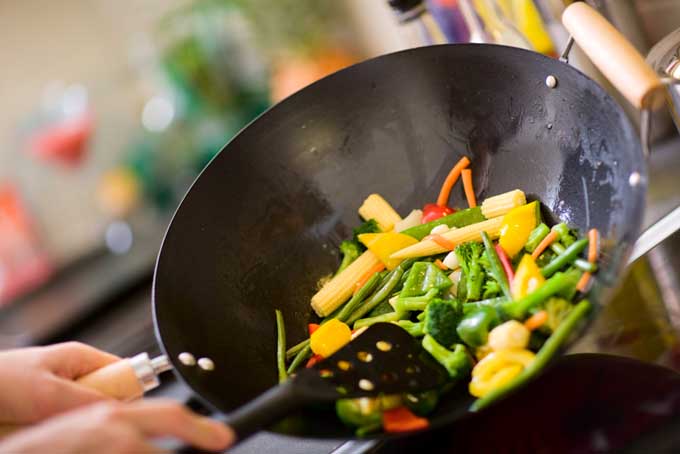
But, in today’s marketplace, there’s a lot of variety to choose from. There are traditional woks that require seasoning and will develop their own flavor with each use, and there are those of a more contemporary nature, suitable for people who prefer to clean their pans after each use, or who enjoy the aesthetics of a polished collection of cookware.
So, to help with the decision process, let’s have a brief look at the history of the wok and its characteristics. Then we’ll go over some product reviews, covering both customary and modern versions of this superb cooking pan.
Bottom Line Up Front: Our 9 Best Reviewed Woks
- Lodge Pro-Logic 14-inch P14W3 Cast Iron Wok
- Wok Shop’s 14 Inch Flat Bottom Carbon Steel Wok w/ Helper Handle
- All-Clad Stainless Steel Tri-Ply 5-Quart Open Stir Fry Pan
- Helen Chen’s Asian Kitchen 14-inch Carbon Steel Flat Bottom Lidded Wok Set
- Wok’s Shop’s 14″ Carbon Steel Pow Model
- Joyce Chen 14 inch Lightweight Cast Iron Model
- ExcelSteel 13-Inch Super Lightweight Cast Iron Model
- Cooks Standard Multi-Ply Clad Stainless-Steel 13-Inch Wok with Dome Lid
- Calphalon Premier Hard-Anodized Nonstick Wok
Note: the links above lead to pricing, customer reviews, and more information and specifications on Amazon or other major retailers.
Wok History
The wok is considered to be one of the most versatile cooking pans, perfect for stir frying and to use in recipes like our lemon chicken quinoa bowls. A fairly recent development in cookware, its use can be verified in China some 2,000 years ago. However, historians and metallurgists can’t agree if it was invented there, or if the wok is a utensil originally borrowed from other cultures.
Regardless of its country of origin, it is one of the most common cooking pans used today throughout Asia, and is now well known and loved in the western hemisphere as well.
The earliest evidence of woks were pottery models in found in Chinese tombs equipped with ovens for the afterlife, and archeology records the first metal woks as dating from the Han Dynasty, circa 200 BC-200 AD.
As pans of a similar shape and size were used in in India and Southeast Asia as well, archeologists speculate that the Chinese wok is an idea that was adopted from neighboring regions. These people used metal buckets turned upside down to serve as braziers for the quick frying of foods – the origins of stir frying.
Its first purpose was for drying grains, and much later farmers adapted it for the spreading and drying of tea leaves. Evidence of the thin slicing of foods, a preparation technique used in stir frying, is first found in the mid-1200s.
It was during the 13th century that tribes of central Asian nomads were expanding their territories.
Most were very open to adopting and adapting the technologies of the surrounding cultures that they traveled through.
Among these nomads were the Mongols, who were unifying these divergent, migrating clans and their cooking methods. For the Mongols, cooking utensils needed to be lightweight and easily transported to suit their nomadic lifestyle, and the wok fit the bill perfectly.
For the traveler, the wok heated fast and food could be cooked quickly, requiring very little cooking oil or fuel for heating. And, being steel, it could be transported with little damage and needed even less maintenance.
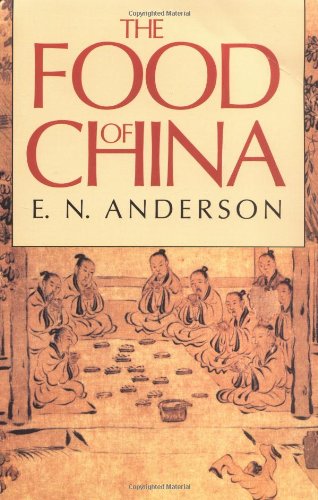
The Food of China by E. N. Anderson
As these nomads conquered and expanded their territory, the wok was introduced to many more cultures and its popularity grew in new realms – particularly in regions of harsh geography and uncertain political climates. In his book, The Food of China, author and anthropologist E. N. Anderson makes this intriguing observation:
“Chinese cooking is the cooking of scarcity. Whatever the emperors and warlords may have had, the vast majority of Chinese spent their lives short of fuel, cooking oil, utensils, and even water.”
The wok was the ideal cooking pot for these times and circumstances.
Wok Hei
The translation of wok hei into English means “wok thermal radiation,” but that explanation falls a bit short. Metaphorically, it’s the “breath of the wok,” or a characteristic the pan takes on when certain conditions are met, almost like a personality trait.
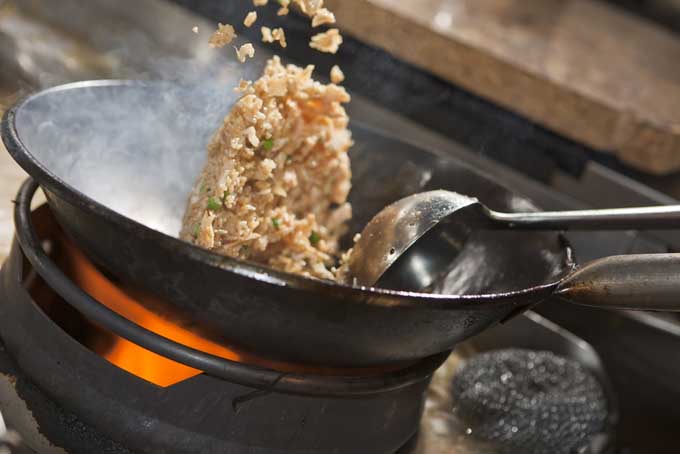
It refers to the richly blended, smoky taste imparted when food is stir fried over high heat, with just the right amount of oil in a wok with a well-seasoned patina. And it’s of significant importance for those Chinese dishes that require searing at high heat.
Creating wok hei can be an elusive endeavor, and its attainment is often used to measure the skill of Chinese chefs who may spend years perfecting their art.
However, if you don’t have the time or inclination to develop your wok hei skill set, very satisfactory results can still be obtained with a standard stir fry pan in your own kitchen.
Construction
Today, woks are available in a wide variety of materials, but the traditional model made of uncoated carbon steel is still the most popular choice. This material heats quickly, transfers the heat well, will form its own nonstick coating, and is one of the most economical to produce (and therefore, to purchase).

Cast iron is another popular choice because of its superior heat retention and conductivity, and it too will form a nonstick surface if care is taken in seasoning and maintenance. With both carbon steel and cast iron, washing with soap and water isn’t recommended, as this may remove the patina of seasoning.
If the idea of not washing your pans after cooking is problematic, consider using stainless steel with a disk bottom or tri-ply construction for stir frying instead. Your dishes won’t have the same wok hei as the heritage materials, but your food will be delicious nonetheless. And cleaning won’t be a problem.
Other materials to select from include electric, ceramic coated cast iron, anodized aluminum, and those with Teflon or other nonstick surface treatments. However, those materials do have the usual drawbacks: nonstick treatments may release toxic chemicals at high heat and aren’t suitable for use with metal utensils, and ceramic coatings can chip and crack.
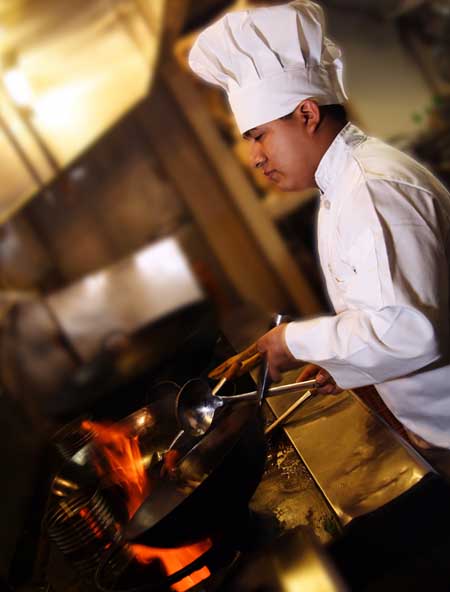
When deciding what type of wok to select, consideration should be given to the type of stove you’ll be using. Historically, Chinese ovens where made of brick with openings in the top for a wok to sit in, directly over the flame. And even today, a Chinese gas range will have larger burners than in the west, facilitating the use of round-bottomed pans.
If you have a gas stovetop, either a round-bottomed or flat-bottomed stir fry pan will work. But, if you have an electric or induction range, the flat-bottomed style works best because it will sit directly on the element, eliminating the need for a ring stand.
Home versions range in sizes from 10″ to 16″, with the 14″ size considered to be adequate for the preparation of most dishes for an average family.
Shape
Regardless of the material used in construction, the shape, diameter and height should be considered – i.e. its concave properties. One that is too deep will retain the heat in the well, or bottom, and heat transfer to the sides will be inadequate.
If it’s too shallow, you’ll lose the ability to toss and move foods up the sides, losing workable surface areas. So, look for the Goldilocks properties of a minimum of 5” for the flat bottom, with a 4” depth for a pan that’s 14” in diameter.
Accessories and Utensils
Some woks are sold as an individual unit, while others come in a set with a lid, burner rings, a thin metal spatula (chuan), ladle, steamer tray, etc.

VERTI Stainless Steel Asian Turner (Chuan)
Determine the most common uses in your home before making your selection – besides stir frying, steaming, smoking or deep frying are all options, and will require extra pieces for culinary success.
Wok Reviews
Lodge: Best Rated Cast Iron Model
Pre-seasoned and ready for use, this one-piece construction cast iron wok features two loop handles, making it oven safe, and the sturdy flat bottom is good on all stove tops. Cast iron is well known for its superior heating and heat retention properties, and this pan has a large surface area.

Lodge Pro-Logic 14-inch P14W3 Cast Iron Wok
Made in the US by Lodge, one of the best known manufacturers of cast iron cookware, this pan should be washed by hand only.
What Others Are Saying
Fantastic, heavy duty performance, the cast iron gets blazing hot and holds the heat for outstanding performance. There’s a lot of rave reviews about it being a great investment. The customers with complaints report it’s too heavy with a rough interior surface.
See more customer reviews and prices on Amazon now!
Wok Shop’s 14″ Flat Bottom: Best Rated Carbon Steel Wok
This pan is made of 14-gauge carbon steel with a blond wood stick and helper handles, and it is made in the US. The 6” bottom and 4” depth are a good match for the 14” diameter, and the flat bottom works well for gas and electric stoves.
14 Inch Flat Bottom Carbon Steel Wok w/ Helper Handle
Hand wash only, season before using, and re-season as needed.
What Others Are Saying
The sturdy, padded bottom heats quickly and holds heat well, and it is made for durability. It’s easy to season, and has a nice shape for moving food while stir frying. On the negative side, there were a couple of complaints about it not sitting flat on glass top ranges – but, as it’s not recommended for glass tops, perhaps the problem was more in the selection. Another few complaints are about rusting after the first use, but again, I think this is due to a lack of understanding that the seasoning process may require more than one application.
See more customer reviews and prices on Amazon now!
All-Clad Tri-Ply Bonded Stir Fry Pan: Best Stainless Clad Model
At 14” with 18/10 stainless steel and an aluminum clad base, this stir fry pan boasts superior heat conductivity with its 6” flat bottom. The stay cool stainless steel stick and loop handles are riveted in place, and this pan has the All-Clad reputation for quality.

All-Clad 4414 Stainless Steel Tri-Ply Bonded Dishwasher Safe 5-Quart Open Stir Fry Pan
Made in the US, it’s good for all range types and is oven and dishwasher safe as well, although hand washing is recommended.
What Others Are Saying
The All-Clad fans report this pan to be sturdy with solid construction, it has a nice balance and good heft, the entire cooking surface heats quickly, and it’s easy to clean. There are a couple of comments from earlier purchasers about sharp edges on the lip of the pan, but none recently.
See more customer reviews and get prices on Amazon now!
Helen Chen’s Asian Kitchen
This pan is made of traditional carbon steel of 1.6 mm depth for rapid and even heating, and it is made in China. The heat-resistant stick handle and helper handle are made of natural bamboo, and the stick has a loop for vertical storage. It requires an initial scouring and seasoning plus re-seasoning to prevent rust formation.
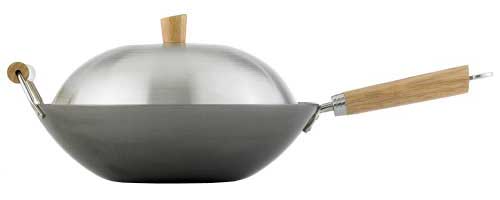
Helen Chen’s Asian Kitchen 14-inch Carbon Steel Flat Bottom Lidded Wok Set
It comes with a lightweight aluminum lid, and the flat bottom is suitable for use on gas and electric ranges. Hand wash only.
What Others Are Saying
The positive reviews indicate a well-constructed pan with good conductivity, and even heating throughout the surface areas. On the negative side, a number of reviewers remarked that the lacquer coating took a lot of scrubbing to remove, and there were several complaints about the wok rusting.
Some of these complaints seem to come from those that aren’t aware carbon steel may require more than one seasoning treatment, but adequate seasoning does seem to take a long time with this model.
Read all of the customer reviews on Amazon now!
14” Carbon Steel “Pow” Model by the Wok Shop
This flat-bottomed pan is make of 14-gauge carbon steel with a metal handle in one piece construction, typical of the Pow style. The measurements of 14” in diameter and 4” deep with a 5” bottom work well for holding and moving ingredients with ease.

Wok’s Shop’s 14″ Carbon Steel Pow Model
Made in the US, this pan is suitable for gas and electric ranges. It must be seasoned before using and hand washing is recommended.
What Others Are Saying
A fairly new product on the market, there aren’t a lot of reviews yet, but customers report a nice shape for stir frying with good conductivity and heat retention. It also seasons well and has a nice heft. One complaint so far about a warped bottom after heating.
Check prices and read all the reviews on Amazon now!
Joyce Chen’s 14” Lightweight Cast Iron Model
This lightweight cast iron stir fry pan is pre-seasoned and ready to cook. It features an easy to clean silicone exterior surface with maple stick and helper handles. The bottom measures 6.5” and is suitable to use on all range tops. Hand wash only.
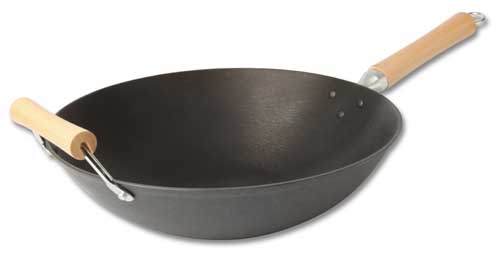
Joyce Chen 23-0001, 14 inch Lightweight Cast Iron Wok
What Others Are Saying
Lightweight for cast iron with durable construction, this pan gets “super” hot and is easy to clean. There are two complaints about the nonstick coating peeling off, even though it’s not nonstick – they probably just needed to be re-seasoned.
Find more details and prices on Amazon now!
Excel 13” Lightweight Cast Iron
50% lighter than traditional cast iron, this wok comes with stainless steel riveted stick and helper handles, and a slot in the stick for vertical storage. The flat 7” bottom is good on all stove tops and is oven safe as well. Hand wash only.
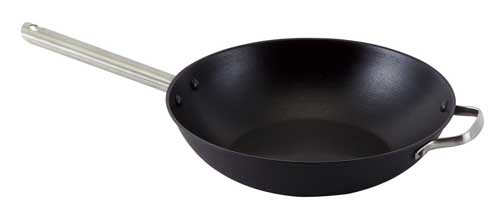
ExcelSteel 13-Inch Super Lightweight Cast Iron Wok
What Others Are Saying
Lightweight for cast iron, this pan heats evenly and holds the heat well. With a large surface area, it shows good performance, is well constructed and cleans well. The main complaints are that it comes unseasoned, and has a rough interior surface.
Get prices and more customer reviews on Amazon now!
Cook’s Standard Multi-ply Clad Stainless Steel with Lid
This pan is 13” with premium 18/10 stainless steel and has an aluminum clad disk bottom for fast and even heating, with V-shaped solid stainless riveted handles for stay cool air flow. It comes with a stainless dome lid with loop handle and has a 5” bottom.
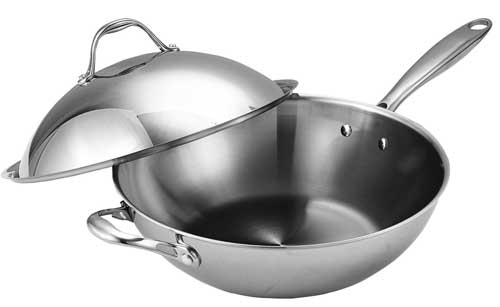
Cooks Standard Multi-Ply Clad Stainless-Steel 13-Inch Wok with Dome Lid
Good for use on all stove tops, it’s also oven safe to 500°F, and can be washed in the dishwasher. Made in China.
What Others Are Saying
Satisfied customers report this is a good product of sturdy construction, the handles stay cool, and it heats evenly with easy clean up. Some naysayers report poor quality construction and that the interior stains easily.
Get more details on Amazon now!
Calphalon Premier Hard-Anodized Nonstick Wok
The three-layer nonstick coating on Calphalon’s Premier Hard-Anodized Nonstick 13-inch Wok is ultra-durable with effortless food release.
Calphalon Premier Hard-Anodized Nonstick Wok, available on Sur La Table
It is oven-safe up to 450°F.
The handle stays cool, and will keep your hands from getting hot when you maneuver the wok.
The wok is dishwasher safe and can be used with metal utensil tools without the risk of permanent scratching.
Get prices and more information on Sur La Table now.
And that concludes our look at the amazing wok. Before making a purchase, decide how you’re going to use it and what type of stove you’ll be cooking on to get the best pan for the job.
About Lorna Kring
Recently retired as a costume specialist in the TV and film industry, Lorna now enjoys blogging on contemporary lifestyle themes. A bit daft about the garden, she’s particularly obsessed with organic tomatoes and herbs, and delights in breaking bread with family and friends.



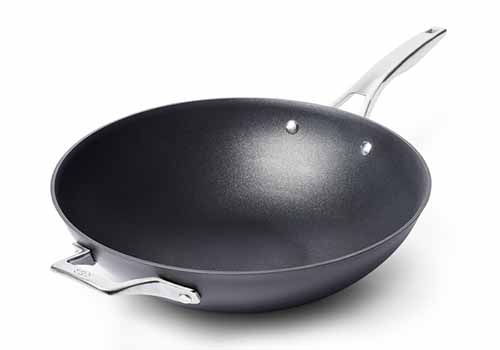
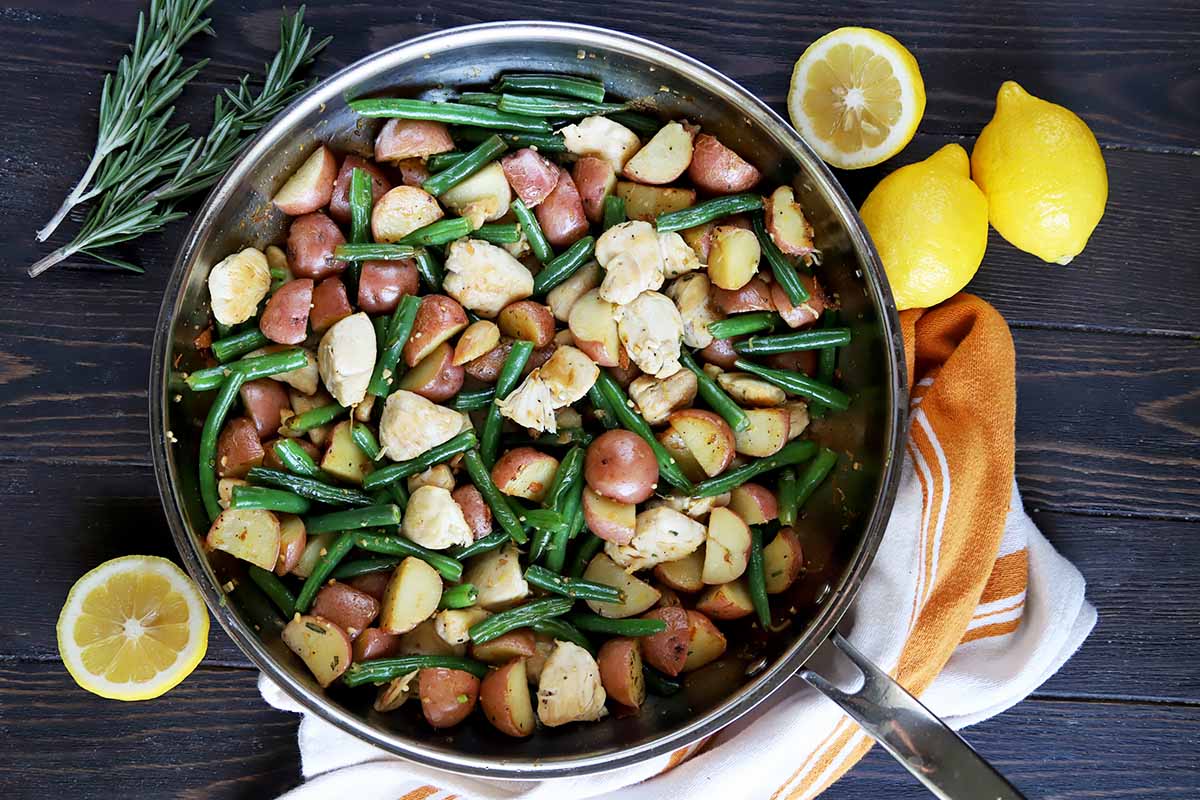
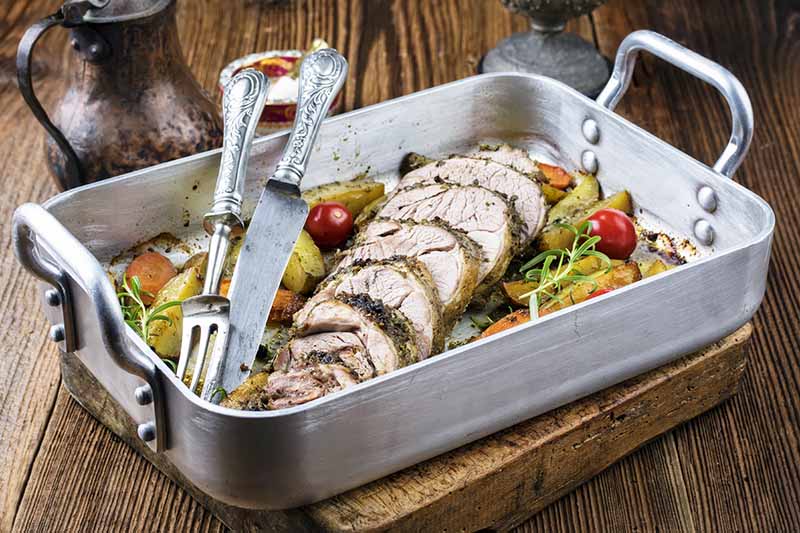
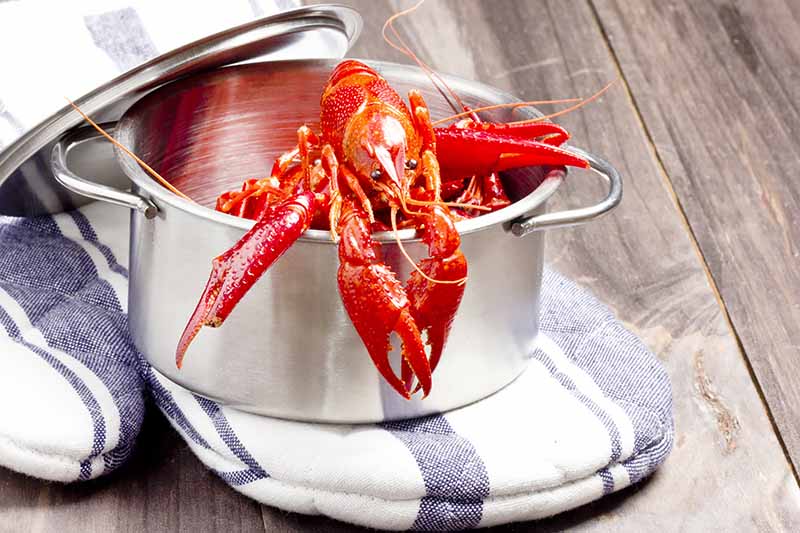
I just recently read another article here about choosing certain types of woks. Is cooking with one a summertime thing more than it is used in any other season? It doesn’t seem that way but I have noticed more conversations surrounding them in the spring/summertime.
I’m not sure Joan, but I do like to take advantage of the spring/summer veggies for stir frying – and the warmer it gets, the less time I want to spend in the kitchen, and a stir fry is great for a quick meal.
This is a very in depth and helpful article! I’ve been looking to buy a new model, something a bit more advanced than the simplistic version I currently own. Thank you for posting the pros and cons of the major brands. I know that the type of wok one cooks on is every bit as important as what one cooks in it! Also liked the brief history as well, very interesting!
Thanks for your comments FoodieAlert, glad you found the post helpful and interesting. Let us know what type of wok you decide on.
Thank you for this guide! It’s great to be able to narrow down my possible choices. I like the look of the All Clad stainless steel model, but the Wok Shop carbon steel one is also tempting. I’ve never seasoned cookware of any sort so that’s slightly intimidating, but attempting to create that “wok hei” would make me feel more authentic.
Thanks Leopard, glad you enjoyed the post. It is a bit of a tug between the stainless and carbon models… Seasoning cookware isn’t difficult, but it is important to keep in mind that it’s a process and re-applications will most likely be needed, it’s not necessarily a one-time thing.
In reviewing the carbon models, a lot of customers complained about rust after just a couple of uses – and I suspect that’s because they thought the seasoning had been completed, when really it had only just begun.
And if you like the idea of wok hei, you’ll probably enjoy the seasoning process… it’s a bit like creating an heirloom as you go.
I grew up with my parents cooking with woks and they have a come long way since my childhood. I like the models with a lid as I do think they can help simmer and another thing to look for is the weight. The easier it is to lift the better it is for you to toss food in as well as investing in good utensils.
How nice to grow up with that influence, and you make good points Bella. Steaming won’t happen without a lid, and the weight of the pan is certainly an individual factor in purchasing. Thanks for your insights.
Truth? I’ve never cooked out of one before. I’ve never eaten anything cooked on one either unless it was a Chinese food restaurant. I have wanted to try it for a while now, I just had no idea where to start. It seemed just a little overwhelming, I guess. But thank you for this!!
The journey to wok hei begins with a single stir fry… glad you found some direction in the article.
My husband recently started using ours and he drives me insane because he doesn’t like that I leave the “seasoning” on it. After reading this article, I have other options to present to him. Thank you for providing so many of the different examples for each situation. You provided the options for many different models AND how to use them. 😉 Thanks!
Oh, the spouse that washes off the seasoning… I understand your pain kristin! Glad you enjoyed the post.
We were lucky to grab a really nice steel example from Goodwill last year. It’s lasted us a long time, and we use it quite often, as a family who makes a lot of stir-fry. The difference between a wok and a regular pan may seem superficial, but I really do think it improves the quality of the food.
Good score on that Bozusaki… and I have to agree with you, I believe there’s a distinct flavor difference in cooking with one and a regular pan.
Thank you for the historical information and product recommendations. We cook a lot of asian foods in our house but we do not have a wok. I have never used one in fact. I tend to use my big cast iron skillet for most everything since it heats up well, can go in the oven, and food does’t seem to stick to it nearly as much as my stainless steel pans.
I never knew there were cast iron options for these, so I am really interested in those.
I am just wondering if cooking in a one as compared to a nice cast iron pan really makes much of a difference? This is the only thing truly holding me back from getting one. I am just not convinced that they will truly make a noticeable difference in the food’s outcome. Any thoughts?
To be honest, I think my stir fry’s come out better in one. The veggies always have a consistent tender/crisp texture that seems to be a bit more hit and miss with a cast iron skillet – perhaps because it’s lighter and I can toss it easier. I love cast iron, but for Asian dishes my carbon steel wok gets the top shelf.
I have been using woks almost every day for most of the last 30 odd years. I have been toying with getting a stainless one for at least a decade, but would prefer something bigger than the usual offerings. I saw a 46cm (~18″) one about 3 years ago, but it was over $300 which is more than ten times what I’ve paid for any. Does anybody here know of such a thing, that is reasonably priced and available in Australia? preferably with welded on handles (no rivets).
Hmm, you might need to make a trip to one of the Chinatown districts… any Aussies out there with a tip for udi?
Well I happen to love a good stir fry, and having a good wok really makes a big difference when it comes to the ease of preparing and cooking the whole meal. Sturdiness and ease of cleaning are probably the two factors that I would say mean the most to me, and for that I think that I have found a good one. I have a carbon steel wok, and it is a good weight and pretty easy to clean afterwards, even when using some of those sloppy sauces. Thanks for sharing this, and I might just have to whip up some stir fry here pretty soon.
Carbon steel is a wonderful wok material rz. And like you say, easy to clean once it’s seasoned… thanks for your thoughts!
Wow. I didn’t know so much thought went into choosing a wok. I use a wok a lot when I’m cooking, I’ve been using one that my mother gave me decades ago and come to think of it, it might be time for a new one. Thanks to your informative article I will be able to get the best possible one for my kitchen.
Glad you found the post helpful Clair. And hope you find a good one!
What is the difference between carbon steel wok and iron wok? Which is better?
Am I reading that carbon steel don’t seem to be recommended for ceramic glass stove tops? That’s too bad as I was loving your article and leaning towards them. Seasoning sounds fun, cast iron seems heavy, and the stainless steel will never be nonstick without a ton of oil, in my experience.
That’s actually incorrect, Hathamark- carbon steel is generally regarded as one of the BEST cookware materials for glass top ranges, since frying pans made from this material typically have smooth, flat bottoms. Cast iron, on the other hand, may scratch the surface of your stovetop, and materials such as porcelain-coated enamel may actually melt and fuse with the surface of your cooktop.
The issue here is more due to the fact that woks have rounded bottoms, so they won’t sit flat on a glass top stove.
Been a bit single too long I think. I do 90% of my cooking on a 10mm thick flat mild steel BBQ plate which is now 40 years old and seen well over 5000 cook ups. Never washed it once except when the Lord showers it.
Its been coated in slugs, snails, ants, cats, a stray dog once licked it clean.
My favourite chow is fried rice. Make up a 1 kilo batch and fridge whats left over for later meals. Keeping life easy and re – l a x e d.